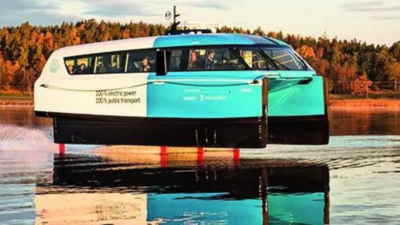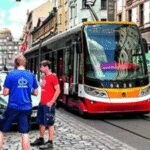During the golden age for ferries in the 1800s, steamboats dotted the shorelines of coastal cities to transport passengers. Then cars and trains took over. Now, driven by congestion and the revitalisation of urban waterfronts, ferries are making a comeback. But, what operators struggle to offer is a fast, sustainable mode of transit. “Commuters want speed,” said Jakob Kuttenkeuler, a professor of naval architecture at the KTH Royal Institute of Technology in Stockholm. Over the last few months, however, Stockholm has been testing a vessel that may solve that problem: the world’s first electric hydrofoil ferry. Developed by a Swedish start-up, Candela, a 30-seat, battery-driven vessel known as the P-12 has almost halved the commute time of a conventional diesel ferry – to 30 minutes – across an 11-mile stretch between the island of Ekero and City Hall in the centre of Stockholm. At the same time, the P-12 emits 95% less emissions than the diesel ferry and uses 80% less energy, according to SL, the Stockholm public transport authority. Gustav Hasselskog, Candela’s founder and chief executive, said the realisation, 11 years ago, that his speedboat guzzled 15 times as much fuel as his car had set him on a course to develop an energy-efficient maritime solution. “High-speed passenger ferries and boats are the least fuel-efficient mode of transit in the world because almost all energy is used to push away the water,” he said. “If you convert to electric, you need massive amounts of batteries, which are expensive and have limited range. The only way to go far and fast on the same battery is when you hydrofoil.” Hydrofoils are the winglike structures mounted under a boat’s hull to lift the craft above the water as it gains speed, much as airplane wings do through the air. The technique drastically reduces drag from water friction and allows for faster, more energy-efficient travel.Kuttenkeuler, who invented the Efoil, an electric hydrofoil board that glides above the water’s surface, said hydrofoil technology was a common marine transport system in the 1980s but was phased out because of the high operational costs. Advancements in digitalization, composite materials and sensor technology have contributed to its comeback, he added. In addition to the environmental benefits, the electric hydrofoil has several other advantages. The batteries are relatively small, so they do not require massive charging infrastructure. They do not generate waves that erode the shoreline or wreak havoc for windsurfers and moored boats in their wake. And because they are kept level by a computer and soar over the waves, they do not cause seasickness. So far, Mumbai, India, has the most ambitious plans for the P-12. JalVimana, the local shuttle operator, will begin with 11 ferries on popular tourist routes from the Gateway of India to Alibag and Elephanta Island. A third route will connect the airport with the centre of Mumbai, cutting travel time from 90 minutes by car to less than 30 minutes on the water.









